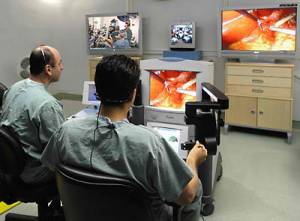Telehealth and Surgery
Hands, Jones, Clarke, Mahaffey and Bangs (2004) conducted a feasibility study of telemedicine as an alternative to conventional outpatient appointments for 22 patients referred to a vascular clinic for a pre-surgical consult in the United Kingdom. The authors noted that their patient population is typically elderly and socially isolated which makes traveling difficult. Each videoconference session involved the patient, practice nurse and vascular consultant. The authors found that all standard assessment information if sent prior to the consult with a form and an accompanying a digital photo and followed by a videoconference consultation with the support of a practice nurse enabled them to satisfactorily assess patients with vascular symptoms at a distance. Overall 27 conventional outpatient appointments were replaced by a videoconference teleconsultation. Aarnio, Rudenberg, Ellonen and Jaatinen (2000) conducted a prospective study of user satisfaction with teleconsultations for surgery. The study group consisted of 50 patients who17 required surgical consultation and involved the patient, the GP and Surgeon. The GP carried out the physical exam according to the surgeons instructions.
The videoconference systems used 3ISDN lines providing 384 kbit/s bandwidth to connect the Satakunta Central Hospital in Pori, Finland and two health centres in the cities of Kanaanpaa and Huittineen located 55 and 60 km from Pori respectively. A document camera was also used to capture images of radiographs and paper documents. Questionnaires were used to collect data from patient and physicians after every consult. The consulting surgeons felt that videoconferencing worked well or very well in 48 out of 50 cases, GPs in the health centres felt the consultation was useful in 49 cases, and overall patient satisfaction was very good or good in 45 cases. Both GPs and Specialists felt that the decisions made during the teleconsultation were as reliable as those made at an outpatient appointment. Rodas, Mora, Tamariz, Cone and Merrell (2005) studied the use of low-bandwidth telemedicine for pre and postoperative evaluation of patients treated by a mobile surgery service in remote Ecuador. Between February 2002 and July 2003, 144 patients were studied preoperatively and 50 post-operatively.
Diagnosis and management plans made by a surgeon via telemedicine (realtime video and store and forward) were compared with those made independently by a second surgeon who saw the patient face-to-face. Real-time videoconferences were attempted in 75 of the cases and of those 55 videoconsultations were not useful because of restricted bandwidth or dropped connections. Therefore only 20 satisfactory preoperative real-time connections that enabled good-quality, simultaneous audiovisual transmission occurred. No technical problems occurred in the store and forward condition. Agreement on diagnosis and management between the videoconferencing and face-to-face conditions was 77% in preoperative evaluation and 97% in postoperative evaluations. The authors discussed that without real-time communication between the two sites, it was difficult to request additional information and wasted time for both doctor and patient.
However, the authors still concluded that telemedicine (presumably store andforward) may reduce time required on site for preoperative planning and may provide reliable postoperative surveillance, improving efficiency of mobile surgery services. The studies reviewed found that videoconferencing could be effectively used to provide pre and post surgical evaluations and consultations. Both patient and physician satisfaction with videoconferencing was high and specialists felt that decisions about the need for surgical treatment were as reliable as those made at face-to-face appointment. Patient populations were either elderly and socially isolated or residing in remote areas thereby having difficulties accessing specialty services. Once again, the need for high bandwidth was noted (without it, the majority of videoconsultations in one study were not useful). The advantage of videoconference over store and forward was the ability to request additional information in real-time.
Source:http://www.isfteh.org/files/work_groups/Companion.pdf

